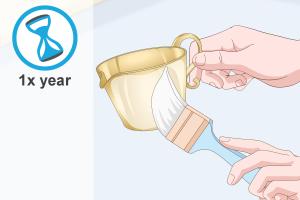Mastering the Art: A Comprehensive Guide to Refinishing Brass

-
Quick Links:
- Introduction
- Understanding Brass
- Why Refinish Brass?
- Tools and Materials Needed
- Step-by-Step Guide to Refinishing Brass
- Case Studies: Successful Brass Refinishing Projects
- Expert Insights and Tips
- Common Mistakes to Avoid
- Conclusion
- FAQs
Introduction
Refinishing brass can breathe new life into your treasured items, whether they are antiques, decorative pieces, or functional fixtures. This comprehensive guide will walk you through the process of refinishing brass, offering tips, techniques, and expert insights to ensure your project is a success.
Understanding Brass
Brass is an alloy primarily made of copper and zinc, known for its durability and resistance to corrosion. It has been used for centuries in musical instruments, decorative items, and plumbing fixtures. Understanding the properties of brass is essential for effective refinishing.
Why Refinish Brass?
Refinishing brass serves several purposes:
- Aesthetic Appeal: Restored brass items can enhance the visual appeal of your home.
- Value Preservation: Proper refinishing can maintain or even increase the value of antique brass items.
- Durability: Refinishing can protect brass from further tarnishing and damage.
Tools and Materials Needed
Before you begin the refinishing process, gather the following tools and materials:
- Brass cleaner
- Fine steel wool or brass wool
- Soft cloths
- Protective gloves
- Polishing compound
- Clear coat sealant (optional)
- Masking tape
Step-by-Step Guide to Refinishing Brass
Follow these steps to successfully refinish your brass items:
Step 1: Clean the Brass
Start by cleaning the brass with a suitable brass cleaner. Apply the cleaner using a cloth, ensuring to remove any surface dirt and grime.
Step 2: Remove Tarnish
Use fine steel wool or brass wool to gently scrub away tarnish. Be cautious not to scratch the surface of the brass.
Step 3: Rinse and Dry
Rinse the brass item with water and dry it thoroughly with a soft cloth to prevent water spots.
Step 4: Polish the Brass
Apply a polishing compound to achieve a shiny finish. Buff the brass with a clean cloth to enhance its luster.
Step 5: Seal the Finish
If desired, apply a clear coat sealant to protect the brass from future tarnishing. Allow it to dry completely.
Case Studies: Successful Brass Refinishing Projects
Let's look at a few case studies where brass refinishing made a significant impact:
- Antique Brass Lamp Restoration: A vintage lamp was transformed from dull and tarnished to a brilliant centerpiece in a living room.
- Brass Door Knobs Revival: Several door knobs refinished and sealed, enhancing both their appearance and durability.
Expert Insights and Tips
Experts recommend the following tips for successful brass refinishing:
- Always test cleaners and products on a small, inconspicuous area first.
- Work in a well-ventilated area to avoid inhaling fumes.
- Consider professional refinishing for valuable antiques.
Common Mistakes to Avoid
To ensure a successful refinishing project, avoid these common pitfalls:
- Skipping the cleaning step, leading to poor results.
- Using harsh chemicals that can damage the brass.
- Neglecting to seal the brass after polishing.
Conclusion
Refinishing brass can be a rewarding DIY project that enhances the beauty of your home. By following this comprehensive guide, you can restore your brass items to their former glory, ensuring they continue to be cherished for years to come.
FAQs
1. How often should I refinish my brass items?
It depends on the environmental conditions, but generally, once a year is sufficient for most items.
2. Can I use vinegar to clean brass?
Yes, vinegar can be used, but it may not be as effective as commercial brass cleaners.
3. Is refinishing brass a difficult task?
No, with the right tools and steps, refinishing brass can be a manageable DIY project.
4. What is the best way to store brass items?
Store brass items in a dry, cool place, ideally wrapped in a cloth to prevent scratches.
5. Can I refinish brass with a power tool?
Power tools can be used, but they require careful handling to avoid damaging the brass.
6. How can I maintain the shine of my refinished brass?
Regular dusting and occasional polishing can help maintain the shine.
7. Is it safe to use steel wool on brass?
Yes, but use fine steel wool to avoid scratching the surface.
8. Can I use automotive polish on brass?
It’s not recommended, as automotive products may contain chemicals that harm brass.
9. What is the best brass cleaner?
Commercial brass cleaners designed specifically for metal are typically the most effective.
10. How can I remove deep scratches from brass?
Consider professional refinishing for deep scratches, as DIY methods may not fully restore the surface.
Random Reads
- Mastering minecraft adventure map guide
- How to make a dispenser in minecraft
- Mastering excel updates
- Mastering fill command minecraft
- How to set up wireless internet windows xp
- How to start hearthfire
- How to start programming in assembly
- How to link sheets in excel
- How to light a gas fireplace
- How to wire a breaker circuit